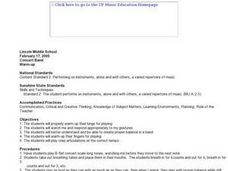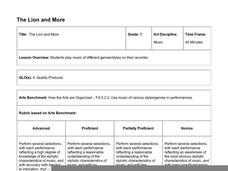Curated OER
Elements of Music
For this music worksheet, 7th graders fill in the blanks in 7 sentences that describe the elements of music such as tempo, pitch, decay, and duration. They use the words from a word bank at the bottom of the page. They make a word search...
Curated OER
Tempo
First graders listen to 4 songs and describe the tempo of each song. In this tempo lesson plan, 1st graders describe each song's temp and identify the type of word described in each song.
Curated OER
Tempo Contrasts in partner Dances
Students explore the differences in tempo through movement. In groups, students create an original dance phrase and illustrate both fast and slow movement. They share their observations and evaluate each dance according to originality...
Curated OER
Warm-Up
Learners warm-up their lungs for playing. Students watch the band director and respond appropriately to his gestures. They help create a proper balance in the band. Also, learners warm-up their fingers for playing, and students play...
Curated OER
Moving and Grooving with Tempo
Students participate in activities involving folk music using movement to illustrate the musical concept of tempo. The use of a game is used in order to help maintain student involvement in the instructional activity.
Curated OER
A Shape-Note Singing Lesson
Students discover the shape-note method of singing. In this reading and notating music instructional activity, students learn the four shapes of the shape-note method and the tradition of Sacred Harp singers. Students sing the shapes of...
Curated OER
Green Light
How is music like reading? First, listeners rank music from slowest to fastest. How does the music's pace affect your mood? How does this same theory compare to reading? Spark a discussion to identify the similarities.
Boston Symphony Orchestra
The Elements of Music—How do Composers Plan?
The introduction to Tchaikovsky's Swan Lake and the finale of his Symphony No. 4 provide young musicians with an opportunity to investigate the music elements composers employ to develop the themes they want to create. They compare the...
San Francisco Symphony
Quilt Making and Copland's Rodeo
Kids make quilts as they learn about pioneer life and the concept of tempo. The Aaron Copland piece, Rodeo is used to convey rhythm and tempo in music. As the children discuss tempo and rhythm, they also discuss what life was like for...
Hawaiʻi State Department of Education
The Lion and More
Melody, rhythm, tempo, and dynamics; get out those recorders it's time to play music! Your class will work on playing two lion-themed pieces that exemplify two different styles, folk and waltz. They'll discuss the elements of music and...
Hawaiʻi State Department of Education
Spontaneous Inventions
Reading out loud can be a real thrill for some, and a real issue for others. Teach your class that reading with inflection and fluency can be as easy as singing a song. They'll first analyze two Bobby McFerrin songs for intonation,...
San Francisco Symphony
Aaron Copland: Billy the Kid
Your class can think about the American Old West as they listen for dynamics, articulation, rhythm, and tempo in the Aaron Copland song, "Billy The Kid." They'll explore how Copland uses music to create an image of life for an outlaw in...
Bowland
My Music
Scholars investigate how the tempo of music affects heartbeats. Groups develop hypotheses about music and its connection to heartbeats before carrying out an experiment. They analyze and present data from their investigations.
Curated OER
3-5: Rhythm Beginnings
Students explore tempo. For this rhythm beginnings lesson, students differentiate between steady and unsteady beats. Students clap a variety of tempo and then move to the tempo of a song.
Curated OER
Rhythm II
In this music activity, students study rhythm and learn that it is made up of beat, tempo and meter. Students look at 4 visual patterns and draw what comes next. These are not as easy as they seem.
Curated OER
Silhouettes and Interiors
Middle schoolers create a multimedia piece that integrates drawing and collage. Students learn about metacognition and the discovering of self through genres of art and literature by using these steps: inspiration, brainstorm,...
Curated OER
Sounds Interesting
Play a music game with your budding musicians! They pick various sound cards out of a bag and make those sounds in different ways.
Hawaiʻi State Department of Education
Suki's Kimono
In the story Suki's Kimono drums are used to show mood. Learners discuss mood in the story after they practice playing a simple 4/4 rhythm on their drums. Each group plays the rhythm using a different tempo. They listen to each other...
Classics for Kids
Instruments Have a Family
Are the instruments in Bach's Brandenburg Concerto No. 2 in the same family as those in George Gershwin's Rhapsody in Blue? Elementary musicians work on their music theory and their instrumental ear as they listen to clips of famous...
Classics for Kids
Listen to the Music
Different pieces of music can elicit different emotions from audience members. A quick tempo can make you feel happy, while a largo piece may bring out a melancholy temperament. Elementary musicians learn more about the instruments and...
Curated OER
The Travels of Babar: An Adventure in Scales
Pupils become familiar with the musical notify that are associated with the character in Monstel's The Travels of Babar: An Adventure in Scales, so that they can listen attentively to the performance and understand and appreciate ow the...
Curated OER
DO YOU REMEMBER?
High schoolers explore where a melody and melody fragments enter different voice parts, and adjusts dynamically to enable the listener to perceive these events. Each student uses a rubric to make critical evaluations of the performances.
Curated OER
Let Freedom Sing: A Patriotic Program for Grades 1 - 6
Students explore the history, meaningful background, and significance of Patriotic songs in the eight lessons of this unit. Each of the different grade levels experience a different amount of lessons all culminating in a Patriotic Program.
Concordia College Archives
History and Musical Aesthetics
What are the musical elements that characterize a school's fight song or its alma mater? Class members listen to examples of fight songs and alma maters from various schools, play a listening game, and then create a list of the...
Other popular searches
- Music Training Tempo
- Music Tempo
- Teaching Tempo
- Music Tempo
- Dance Assessment Time Tempo
- Tempo Adagio Allegro
- El Tempo Props
- Music Tempo Allegro
- Temporal Concepts
- Music and Tempo
- American Folk Music Tempo
- Music, Tempo

























